tow Citroen C3 2017 2.G Owner's Guide
[x] Cancel search | Manufacturer: CITROEN, Model Year: 2017, Model line: C3, Model: Citroen C3 2017 2.GPages: 450, PDF Size: 10.11 MB
Page 134 of 450
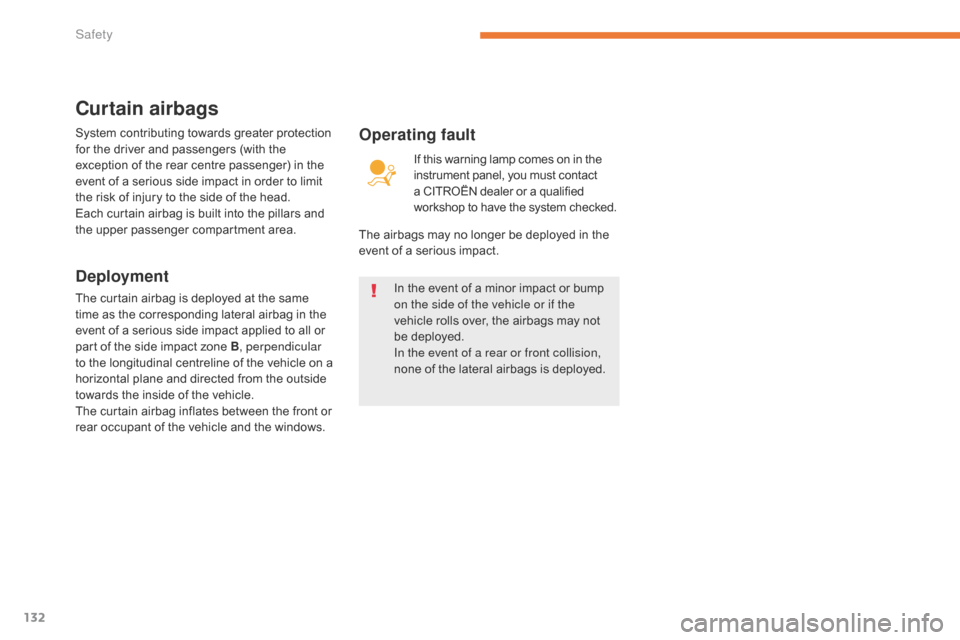
132
B618_en_Chap05_securite_ed01-2016
In the event of a minor impact or bump
on the side of the vehicle or if the
vehicle rolls over, the airbags may not
be deployed.
In the event of a rear or front collision,
none of the lateral airbags is deployed.
System contributing towards greater protection
for the driver and passengers (with the
exception of the rear centre passenger) in the
event of a serious side impact in order to limit
the risk of injury to the side of the head.
Each curtain airbag is built into the pillars and
the upper passenger compartment area.
Curtain airbags
Deployment
The curtain airbag is deployed at the same
time as the corresponding lateral airbag in the
event of a serious side impact applied to all or
part of the side impact zone B, perpendicular
to the longitudinal centreline of the vehicle on a
horizontal plane and directed from the outside
towards the inside of the vehicle.
The curtain airbag inflates between the front or
rear occupant of the vehicle and the windows. If this warning lamp comes on in the
instrument panel, you must contact
a CITROËN dealer or a qualified
workshop to have the system checked.
Operating fault
The airbags may no longer be deployed in the
event of a serious impact.
Safety
Page 144 of 450
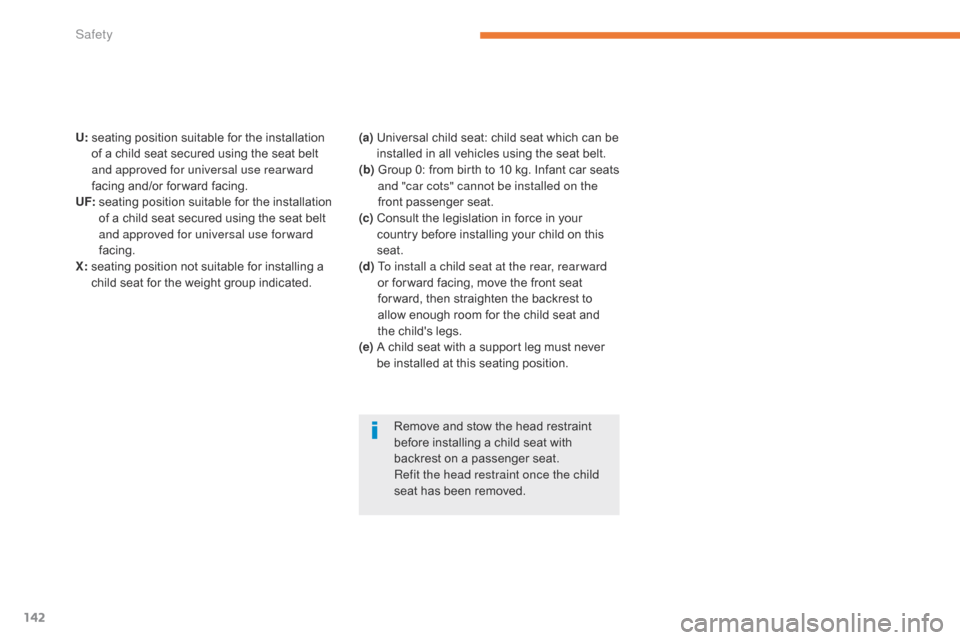
142
B618_en_Chap05_securite_ed01-2016
U: seating position suitable for the installation
of a child seat secured using the seat belt
and approved for universal use rear ward
facing and/or for ward facing.
UF:
s
eating position suitable for the installation
of a child seat secured using the seat belt
and approved for universal use for ward
facing.
X:
s
eating position not suitable for installing a
child seat for the weight group indicated. (a)
U niversal child seat: child seat which can be
installed in all vehicles using the seat belt.
(b)
G
roup 0: from birth to 10 kg. Infant car seats
and "car cots" cannot be installed on the
front passenger seat.
(c)
C
onsult the legislation in force in your
country before installing your child on this
seat.
(d)
T
o install a child seat at the rear, rear ward
or for ward facing, move the front seat
for ward, then straighten the backrest to
allow enough room for the child seat and
the child's legs.
(e)
A c
hild seat with a support leg must never
be installed at this seating position.
Remove and stow the head restraint
before installing a child seat with
backrest on a passenger seat.
Refit the head restraint once the child
seat has been removed.
Safety
Page 145 of 450

143
B618_en_Chap05_securite_ed01-2016
"ISOFIX" mountings
Your vehicle has been approved in accordance
with the latest ISOFIX regulation .
The seats, represented below, are fitted with
regulation ISOFIX mountings:
-
a r
ing B, located behind the seat and
identified by a marking, referred to as the
Top Tether for fixing the upper strap.
There are three rings for each seat:
-
t
wo rings A , located between the vehicle
seat back and cushion, indicated by a
marking, To secure the child seat to the TOP TETHER
:
- r emove and stow the head restraint before
installing the child seat on the seat (refit it
once the child seat has been removed),
-
p
ass the upper strap of the child seat
behind the seat backrest, between the
apertures for the head restraint rods,
-
f
ix the hook of the upper strap to the ring B,
-
t
ighten the upper strap.
When fitting an ISOFIX child seat to the left-
hand rear seat, before fitting the seat, first
move the centre rear seat belt towards the
middle of the vehicle, so as to avoid the seat
inter fering with the operation of the seat belt.
The incorrect installation of a child seat
in a vehicle compromises the child's
protection in the event of an accident.
Follow strictly the fitting instructions
provided by with the child seat.
For information on the possibilities for
installing ISOFIX child seats in your
vehicle, refer to the summary table.
This ISOFIX mounting system provides fast,
reliable and safe fitting of the child seat in your
vehicle.
The ISOFIX child seats are fitted with two
latches which are secured on the two rings A
.
Some seats also have an upper strap , known
as the Top Tether, which is attached to ring B .
5
Safety
Page 148 of 450

146
B618_en_Chap05_securite_ed01-2016
(a) Refer to the legislation in force in your
country before installing a child at this
seating position.
Remove and stow the head restraint
before installing a child seat with a
backrest on a passenger seat. Refit the
head restraint once the child seat has
been removed.
I UF:
s
eating position suitable for the installation
of an I sofix U niversal seat, F or ward facing
secured using the upper strap.
IL -SU :
s
eating position suitable for the
installation of an I sofix Semi-Universal
seat either:
-
r
ear ward facing fitted with an upper strap
or a support leg,
-
f
or ward facing fitted with a support leg,
-
a c
ot fitted with an upper strap or a support
leg.
For securing the upper strap using the ISOFIX
mountings , refer to the corresponding section.
X:
s
eating position not suitable for the
installation for an ISOFIX seat or cot of the
weight group indicated. (1):
t he installation of the cot at this seating
position may prevent the use of one or
more seats in this row.
(2):
a
djust the front seat to the fully for ward
position.
(3):
a
djust the front seat to 16 notches minimum
from the fully rear ward position.
Safety
Page 150 of 450
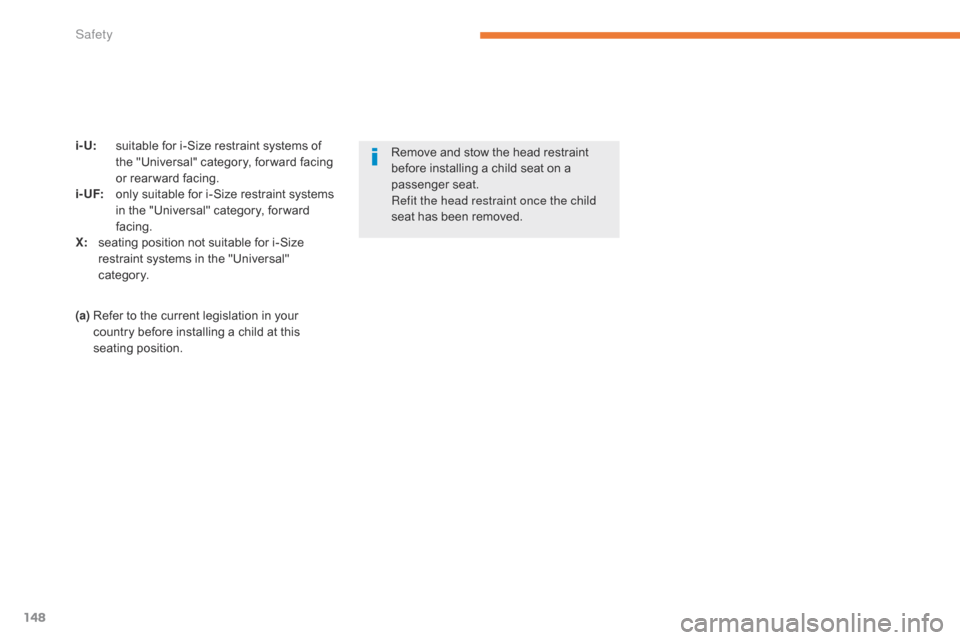
148
B618_en_Chap05_securite_ed01-2016
Remove and stow the head restraint
before installing a child seat on a
passenger seat.
Refit the head restraint once the child
seat has been removed.
i- U: s
uitable for i-Size restraint systems of
the "Universal" category, for ward facing
or rear ward facing.
i - UF:
o
nly suitable for i-Size restraint systems
in the "Universal" category, for ward
facing.
X:
s
eating position not suitable for i-Size
restraint systems in the "Universal"
category.
(a)
R
efer to the current legislation in your
country before installing a child at this
seating position.
Safety
Page 154 of 450
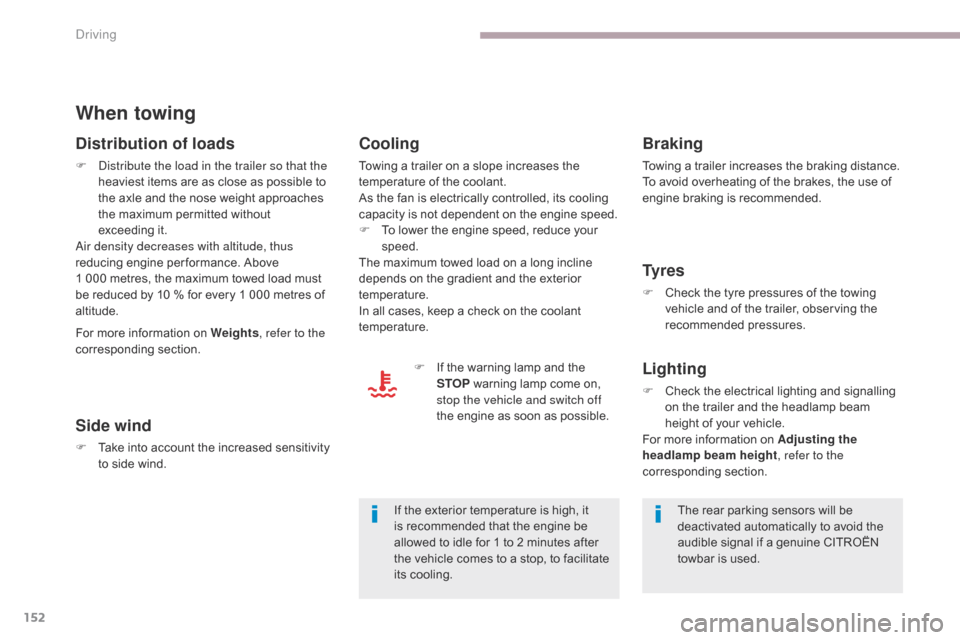
152
B618_en_Chap06_conduite_ed01-2016
When towing
Distribution of loads
F Distribute the load in the trailer so that the heaviest items are as close as possible to
the axle and the nose weight approaches
the maximum permitted without
exceeding
it.
Air density decreases with altitude, thus
reducing engine per formance. Above
1
000 metres, the maximum towed load must
be reduced by 10
% for every 1 000 metres of
altitude.
For more information on Weights , refer to the
corresponding section.
Side wind
F Take into account the increased sensitivity to side wind.
Cooling
Towing a trailer on a slope increases the
temperature of the coolant.
As the fan is electrically controlled, its cooling
capacity is not dependent on the engine speed.
F
T
o lower the engine speed, reduce your
speed.
The maximum towed load on a long incline
depends on the gradient and the exterior
temperature.
In all cases, keep a check on the coolant
temperature.
F
I
f the warning lamp and the
STOP warning lamp come on,
stop the vehicle and switch off
the engine as soon as possible.
Braking
Towing a trailer increases the braking distance.
To avoid overheating of the brakes, the use of
engine braking is recommended.
Ty r e s
F Check the tyre pressures of the towing vehicle and of the trailer, observing the
recommended pressures.
Lighting
F Check the electrical lighting and signalling on the trailer and the headlamp beam
height of your vehicle.
For more information on Adjusting the
headlamp beam height , refer to the
corresponding section.
The rear parking sensors will be
deactivated automatically to avoid the
audible signal if a genuine CITROËN
towbar is used.
If the exterior temperature is high, it
is recommended that the engine be
allowed to idle for 1 to 2 minutes after
the vehicle comes to a stop, to facilitate
its cooling.
Driving
Page 165 of 450

163
B618_en_Chap06_conduite_ed01-2016
Sport and snow programmes
These two special programmes supplement the
automatic operation in very specific conditions
of use.S appears in the instrument panel.
Sport programme "S"
F Press button "S" , after starting the engine.
The gearbox automatically favours a dynamic
style of driving.
Snow programme " T"
F Press button " T", after starting the engine.
The gearbox adapts to driving on slippery
roads.
This programme improves starting and drive
when traction is poor.
T appears in the instrument panel. F
A
t any time, press the button selected
again to quit the programme engaged and
return to auto-adaptive mode.
Return to standard
automatic operation Manual operation
F Select position M for sequential
changing
of the six gears.
F
M
ove the selector towards the + sign to
change up a gear.
F
M
ove the selector towards the - sign to
change down a gear.
It is only possible to change from one gear to
another if the vehicle speed and engine speed
permit; other wise, the gearbox will operate
temporarily in automatic mode.
D disappears and the gears
engaged appear in succession in the
instrument panel.
If the engine speed is too low or too high, the
gear selected flashes for a few seconds, then
the actual gear engaged is displayed.
It is possible to change from position D
(automatic) to position M (manual) at any time.
When the vehicle is stationary or moving
very slowly, the gearbox engages first gear
automatically.
The sport and snow programmes do not
operate in manual mode.
6
Driving
Page 183 of 450
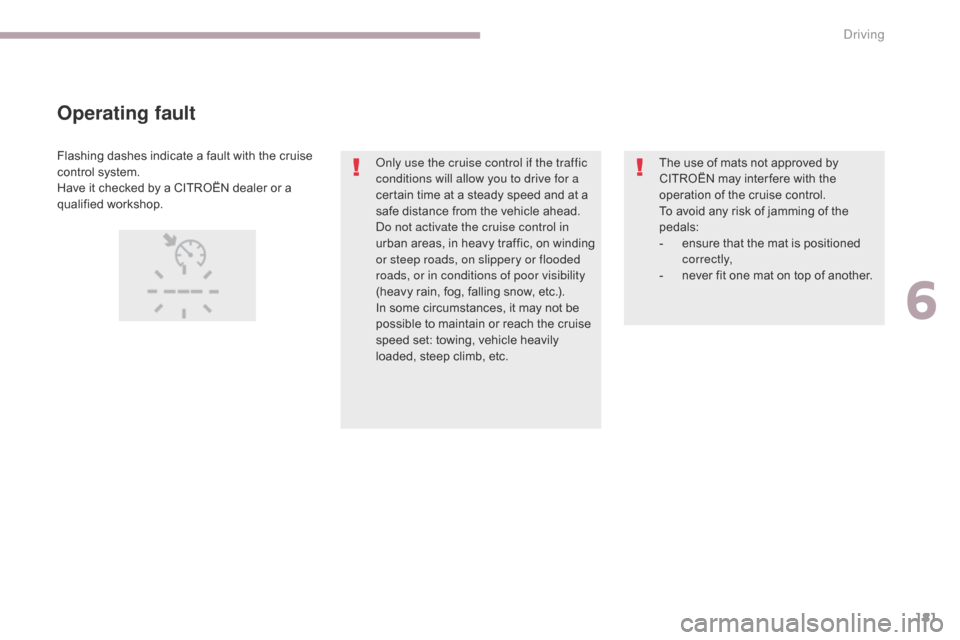
181
B618_en_Chap06_conduite_ed01-2016
Operating fault
Flashing dashes indicate a fault with the cruise
control system.
Have it checked by a CITROËN dealer or a
qualified workshop.Only use the cruise control if the traffic
conditions will allow you to drive for a
certain time at a steady speed and at a
safe distance from the vehicle ahead.
Do not activate the cruise control in
urban areas, in heavy traffic, on winding
or steep roads, on slippery or flooded
roads, or in conditions of poor visibility
(heavy rain, fog, falling snow, etc.).
In some circumstances, it may not be
possible to maintain or reach the cruise
speed set: towing, vehicle heavily
loaded, steep climb, etc.The use of mats not approved by
CITROËN may inter fere with the
operation of the cruise control.
To avoid any risk of jamming of the
pedals:
-
e
nsure that the mat is positioned
c o r r e c t l y,
-
n
ever fit one mat on top of another.
6
Driving
Page 186 of 450
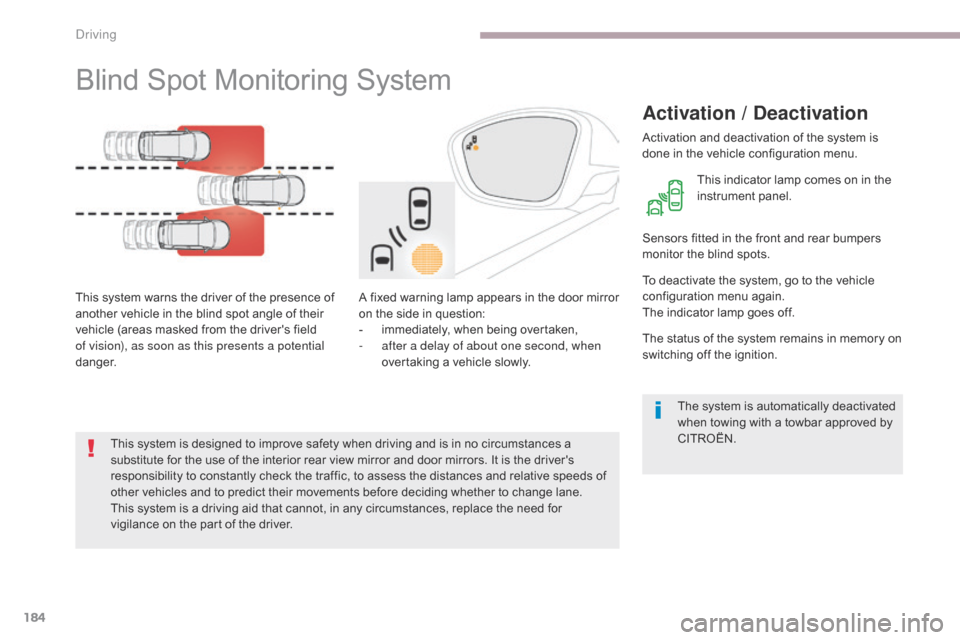
184
B618_en_Chap06_conduite_ed01-2016
Blind Spot Monitoring System
This system warns the driver of the presence of
another vehicle in the blind spot angle of their
vehicle (areas masked from the driver's field
of vision), as soon as this presents a potential
danger.A fixed warning lamp appears in the door mirror
on the side in question:
-
i
mmediately, when being overtaken,
-
a
fter a delay of about one second, when
overtaking a vehicle slowly.
This system is designed to improve safety when driving and is in no circumstances a
substitute for the use of the interior rear view mirror and door mirrors. It is the driver's
responsibility to constantly check the traffic, to assess the distances and relative speeds of
other vehicles and to predict their movements before deciding whether to change lane.
This system is a driving aid that cannot, in any circumstances, replace the need for
vigilance on the part of the driver.
Activation / Deactivation
Activation and deactivation of the system is
done in the vehicle configuration menu. This indicator lamp comes on in the
instrument panel.
Sensors fitted in the front and rear bumpers
monitor the blind spots.
To deactivate the system, go to the vehicle
configuration menu again.
The indicator lamp goes off.
The system is automatically deactivated
when towing with a towbar approved by
CITROËN.
The status of the system remains in memory on
switching off the ignition.
Driving
Page 190 of 450

188
B618_en_Chap06_conduite_ed01-2016
Deactivation or activation of the system is done
via the vehicle configuration menu.The system will be deactivated
automatically if a trailer is being
towed or a bicycle carrier is fitted on
a towbar (vehicle fitted with a towbar
installed in line with the manufacturer's
recommendations). In bad or wintry weather, ensure that
the sensors are not covered with mud,
ice or snow. When reverse gear is
engaged, an audible signal (long beep)
indicates that the sensors may be dirty.
Certain sound sources (motorcycle,
lorry, pneumatic drill, etc.) may trigger
the audible signals of the parking
sensor system.High pressure jet wash
When washing your vehicle, do not
direct the lance within 30 cm of the
sensors.
Deactivation / Activation
In the event of a fault, when reverse
gear is engaged, this warning lamp
lights up in the instrument panel,
accompanied by a message and an
audible signal.
Operating fault
Contact a CITROËN dealer or a qualified
workshop to have the system checked.
Driving